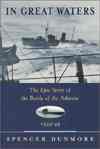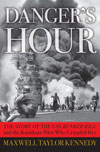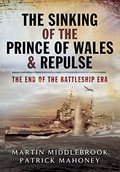In Great Waters
The Epic Story of the Battle of the Atlantic, 1939-45
Dunmore, Spencer
2000, McClelland & Stewart
ISBN 0771029365
Paperback, 342 pages, 30 b&w photos and certificates
| Type. | General History |
| Pros. | Very good and easily readable wide and accurate coverage of the Atlantic naval war, sea and air, with a different Canadian perspective. |
| Cons. | Novelist's approach to subject, somewhat simplistic; relies on previous writings. |
| Rating. |  |
 Spencer Dunmore is perhaps better known in the wider field for his 9 novels of wartime events - Bomb Run, Final Approach, Means of Escape and so on. Since then, and since moving to Canada, he has written three books on the wartime RCAF, detailed reviews of squadrons and the Commonwealth Air Training Plan. And this book reflects those previous interests and experience. Despite its careful attention to historic detail and accuracy, it reads like a novel, in that throughout there are descriptive phrases inserted - "... their fancies creating destroyers and aircraft out of whispy flecks of moonlight and shifting shadows." Aircraft "seemed to tremble with eagerness..." and so on. Thus, while this may bother the academic purists, it makes the book an excellent introduction for the non-specialist to the Atlantic war in general. A good book to recommend to someone wanting an accurate but readable general history that carries you along without the sometimes numbing minutiae of navalese detail.
Spencer Dunmore is perhaps better known in the wider field for his 9 novels of wartime events - Bomb Run, Final Approach, Means of Escape and so on. Since then, and since moving to Canada, he has written three books on the wartime RCAF, detailed reviews of squadrons and the Commonwealth Air Training Plan. And this book reflects those previous interests and experience. Despite its careful attention to historic detail and accuracy, it reads like a novel, in that throughout there are descriptive phrases inserted - "... their fancies creating destroyers and aircraft out of whispy flecks of moonlight and shifting shadows." Aircraft "seemed to tremble with eagerness..." and so on. Thus, while this may bother the academic purists, it makes the book an excellent introduction for the non-specialist to the Atlantic war in general. A good book to recommend to someone wanting an accurate but readable general history that carries you along without the sometimes numbing minutiae of navalese detail.
For sources Dunmore has relied almost entirely on previous publications, in themselves well and fully researched, so not a problem: Alec Douglas's The Creation of a National Air Force (for the RCAF's coastal operations), Gannon's Operation Drumbeat, Adml. Dönitz's Memoirs and Middlebrook's Convoy. He has also interviewed, or re-quoted interviews with a reasonable selection of participants, Canadian, German, American and British; from seamen in corvettes, Coastal Command aircraft crew and U-boat survivors. These again add a realism to his narrative beyond the simple narration of log-book facts. The reliance on these secondary sources, almost all in themselves reliable, is no fault, but in the odd case does perpetuate minor errors, either in their facts or in interpretation. The ASV radar was not fitted in (Canadian) warships but only in aircraft ("air-to-surface-vessel"); convoys were known as HX rather than "Halifax" convoys (a fault corrected as the tale goes on); ASDIC didn't stand for any 1920's-1930's A/S Committee (despite what someone at the Admiralty told Churchill in response to an urgent query!) but was in use in the 1st War. There are a few other not very vital errors due to unfamiliarity: Lutzow was a heavy cruiser, not a pocket battleship; it was Fairmile 'B' motor launches used in the Gulf of St. Lawrence, not MTB's. And the loss table, naturally, doesn't reflect the more recent changes in U-boat loss credits and changes from Clay Blair, due to Bob Coppock's research at the British MoD (Navy).
But these are minor. And, for a Canadian, and a more balanced review of the Atlantic battle, it is a very evenly covered history of all the aspects of that complicated and ever-shifting five year struggle. And for a change, obviously representing Dunmore's previous research into the Atlantic air war, there is more than the usual casual coverage of the RAF's Coastal Command and Canada's Eastern Air Command contribution - poor at first, due to inadequate aircraft and numbers, but growing to major contributors by late mid-war. Writing from his perspective again, the source of many of his examples are Canadian - corvettes, Canadian group escorted convoys, the contributions of Canadian as well as RN and USN elderly "Town Class" 'four-stacker' destroyers, and so forth. In that the RCN arguably contributed 1/3 of the forces in that sea battle, including the Kriegsmarine, this is a reasonable but unusual and differing approach. Thus the reader gets a bit of a new perspective on the battle, usually covered in previous books as if the RN, the USN and the KrM were really the only combatants, with the Canadians and French as ill-welcomed cousins. Additionally he covers briefly the contribution of the merchant ship-building efforts in the US and elsewhere to the eventual massive recovery from the losses of 1941 to early 1943, and such rarely noted detail as the effect of the naval losses at Dunkirk on the protection of convoys. He gives some less than well known detail about the sorry effect of USN Adml Ernie King's Anglophobia on the early Paukenschlag battle of 1942 off the US coast, and his fights with their own USAAF and USN air commanders about control of over-the-sea air patrols.
Dunmore accurately depicts the shortcomings of the early days, in ships, in ships' equipment - particularly radar and D/F in convoy close escorts, in aircraft and their miserable bombs and early depth charges and inadequate ranges; the administrative and even political battles fought to get supplies allocated and crews trained to use them. Included, even for the navally knowledgeable, are small snippets of unusual detail, leading to a careful reading of his story, not a mere skimming: the power supplied in Wellington a/c from batteries for their valuable Leigh Lights, trickle-charged by a small generator; the building of Liberator VLR coastal aircraft by Ford, as well as by Douglas, Consolidated and North American; that the type IXc U-190 went down to 310 metres (1,000 ft.) and survived when attacked by USS Babbitt, an unheard-of depth to survive for those days. The contribution of CAM (Catapult Aircraft Merchantmen) and MAC ships is given their deserved coverage. Again reflecting his own earlier research, we get brief descriptions of sonobuoys and MAD (magnetic anomaly detector) equipment used to hunt submerged U-boats. If one were generally critical of the whole, it would be that throughout there is perhaps an over-weighting of attention to the Atlantic battle air war, compared to the more (numerically) massive sea battle - RN, RCN and USN. But then this was a naval problem as well, for although they wanted air cover, the naval leaders lacked the administrative clout to get it, in British cabinet or in Washington.
The book ends rather too soon, even somewhat abruptly, with the overwhelming of the wolf packs in May, 1943. There are only a brief few pages thereafter, describing the too-late introduction (for the Kriegsmarine) of the new generation of electro-boats and better torpedoes and U-boat radar, and the contribution of the flood of new frigates and Castle Class with their massive depth charge loads and Squid. In fact there is detailed coverage of the climactic battle around convoys HX-229, HX-229A and SC-122 which is really the finale for his story, with but a quick wrap-up. While there is on-going analysis, this is more a story of what went on and why.
On the whole a really well done book, and a good one to recommend if asked "What's good for me to read on the Battle of the Atlantic if I just need a reliable and readable general coverage?"
Review written by CDR Fraser M. McKee, Ontario, Canada.
Published on 14 Aug 2002.
This title is highly recommended.
Purchase information: (info) Get In Great Waters now at amazon.co.uk
Get In Great Waters now at amazon.co.uk
Return to our main review page.



